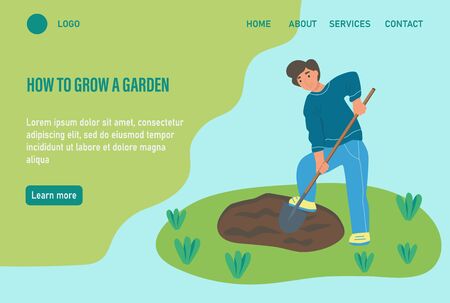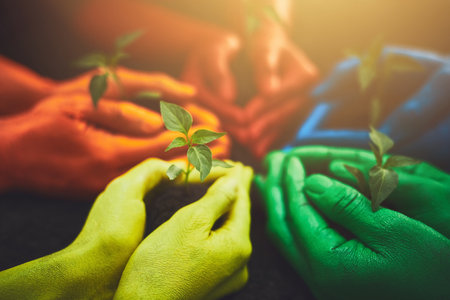1. Understanding the Zero-Waste Mindset
The zero-waste lifestyle is all about reducing what we throw away and making the most of what we have. When it comes to gardening, this mindset means designing and managing your garden in a way that produces as little waste as possible while giving back to the environment. Instead of seeing garden scraps or unused materials as trash, zero-waste gardening finds a purpose for everything—turning potential waste into valuable resources.
What Does Zero-Waste Mean in Gardening?
Zero-waste gardening focuses on minimizing landfill contributions by reusing, recycling, and composting. It’s not about being perfect—it’s about making smarter choices that reduce environmental impact over time. This includes using natural materials, avoiding synthetic fertilizers and plastics, and growing plants that support local ecosystems.
Benefits of Applying Zero-Waste Principles to Your Garden
| Benefit | Description |
|---|---|
| Less Waste | Composting food scraps and yard waste reduces garbage output. |
| Healthier Soil | Using organic matter improves soil structure and fertility naturally. |
| Saves Money | Reusing containers and tools cuts down on gardening costs. |
| Supports Biodiversity | Native plants and pollinator-friendly practices attract beneficial insects. |
| Lowers Carbon Footprint | Growing your own food reduces transportation emissions. |
Shifting Your Perspective: Waste as a Resource
A big part of embracing zero-waste gardening is changing how you view waste. For example, fallen leaves can become mulch, kitchen scraps can become compost, and even old newspapers can be used for weed control. These small shifts help create a closed-loop system where nothing goes to waste.
Everyday Examples of Zero-Waste Thinking in the Garden:
- Compost bins: Turn veggie peels and coffee grounds into rich soil amendments.
- Rainwater harvesting: Collect rain in barrels to water your garden naturally.
- DIY planters: Repurpose old buckets, crates, or jars instead of buying new pots.
- Seed saving: Harvest seeds from your crops to plant next season without buying more.
- No-dig gardening: Reduces soil disturbance and promotes natural soil life cycles.
A Sustainable Lifestyle Starts at Home
Your garden can be more than just a place to grow flowers or veggies—it can become a model of sustainability. By adopting the zero-waste mindset, youre not only helping the planet but also creating a healthier space for your family and local wildlife. Every small step counts, and it all begins with being mindful of how we use resources in our own backyards.
2. Planning with Purpose: Site Assessment and Design
Creating a zero-waste garden starts with understanding your space. Before you plant a single seed, taking time to assess your site can help you make smarter, more sustainable decisions that reduce waste and benefit your garden in the long run.
Understand Your Garden’s Microclimate
Every yard has its own unique set of conditions—sunlight, wind patterns, temperature fluctuations, and moisture levels. These factors create a microclimate that influences which plants will thrive with minimal input.
Key Microclimate Factors to Observe:
| Factor | What to Look For |
|---|---|
| Sunlight | Track how many hours of sun each area receives (full sun, partial shade, full shade) |
| Wind | Note prevailing wind directions and any natural windbreaks like fences or trees |
| Moisture | Identify areas that stay wet or dry longer after rain |
| Temperature | Watch for frost pockets or heat-retaining spots near walls or pavement |
Test and Improve Your Soil Health
Sustainable gardens start with healthy soil. Conduct a simple soil test to learn about pH levels, texture, and nutrient content. This helps you avoid over-fertilizing or using amendments your soil doesn’t need—saving money and reducing runoff.
Soil Texture Guide:
| Soil Type | Description | Sustainable Tips |
|---|---|---|
| Sandy | Loses water quickly; feels gritty | Add compost to retain moisture |
| Clay | Poor drainage; sticky when wet | Add organic matter to improve structure |
| Loamy | Ideal balance of sand, silt, clay; fertile | Maintain with compost and mulch |
Create an Efficient Layout Based on Needs and Resources
A well-thought-out garden layout can reduce waste by placing the right plants in the right spots and making irrigation more efficient. Use pathways, raised beds, or container setups based on your available space and materials you already have. Group plants by water needs to avoid overwatering and use vertical growing structures if youre tight on space.
Sustainable Design Tips:
- Repurpose old pallets or wood scraps for raised beds or trellises.
- Avoid plastic landscaping fabric—use cardboard or newspaper as weed barriers instead.
- Capture rainwater in barrels to irrigate during dry spells.
- Create compost zones close to planting beds for convenience and reduced hauling.
The more intentionally you plan your garden from the start, the less likely you’ll generate waste down the road. By aligning your design with your environment and resources, you’re not just planting smarter—you’re cultivating a garden that gives back season after season.

3. Composting and Soil Renewal Strategies
One of the easiest and most impactful steps in zero-waste garden planning is composting. Its a natural process that transforms your kitchen scraps and garden waste into rich, fertile soil — perfect for feeding your plants and reducing landfill waste. Whether you have a small suburban backyard or a spacious rural lot, there are composting methods suited for every American home.
Choosing the Right Composting Method
There’s no one-size-fits-all approach to composting. Here are some common methods used across the U.S., each with its own benefits:
| Composting Method | Best For | Pros | Cons |
|---|---|---|---|
| Backyard Bin Composting | Most suburban and rural homes | Simple setup, low cost, efficient for most food and yard waste | Takes time (2-6 months), requires turning and maintenance |
| Tumbler Composting | Small yards or patios | Neat appearance, faster decomposition, easy to turn | Limited capacity, can be more expensive |
| Vermicomposting (Worm Bins) | Apartments or homes with limited outdoor space | Compact size, odor-free if done right, fun for kids | Can’t handle large volumes of waste, sensitive to temperature |
| Trench Composting | Larger gardens or raised beds | No bin needed, minimal effort once buried | Takes time to decompose underground, less control over process |
What You Can (and Cant) Compost at Home
Not everything belongs in your compost pile. Heres a quick guide to help you decide what goes in:
| Compostable Items (Yes) | Non-Compostable Items (No) |
|---|---|
| Fruit and veggie scraps, coffee grounds, tea bags (no staples), eggshells | Dairy products, meats, oils, pet waste, glossy paper |
| Grass clippings, dry leaves, shredded newspaper, cardboard (non-coated) | Synthetic fabrics, plastic-lined cartons, treated wood chips |
Tips for Successful Composting
Balance Your Greens and Browns
A healthy compost pile needs a balance of “greens” (nitrogen-rich materials like food scraps) and “browns” (carbon-rich materials like dry leaves). A good rule of thumb is roughly 1 part green to 3 parts brown.
Aerate Regularly
Your compost pile needs oxygen to break down effectively. Turn it every couple of weeks using a pitchfork or compost aerator tool.
Monitor Moisture Levels
Your compost should feel like a wrung-out sponge — damp but not soggy. Add water or dry browns as needed to maintain the right moisture level.
The Payoff: Rich Soil Amendments for Your Garden
After a few months of care and patience, youll have dark, crumbly compost ready to feed your plants. Mix it into garden beds to enrich the soil structure, boost nutrient content, and retain moisture naturally — all without buying synthetic fertilizers.
Sustainable Gardening Starts from the Ground Up
By composting your household and garden waste, youre not just reducing trash — youre creating a closed-loop system that feeds your plants while keeping materials out of landfills. Its an essential piece of any zero-waste garden strategy thats easy to implement right in your own backyard.
4. Choosing Sustainable Plants and Materials
When planning a zero-waste garden, what you plant—and what you plant it in—matters just as much as how you care for it. Making thoughtful decisions about plants and materials can help reduce water use, cut down on waste, and support your local ecosystem.
Go Native: Why Local Plants Matter
Native plants are naturally adapted to your region’s climate, soil, and wildlife. They require less water, fewer fertilizers, and minimal maintenance once established. Plus, they provide food and shelter for local birds, bees, and butterflies.
Benefits of Using Native Plants
| Benefit | Description |
|---|---|
| Water Efficiency | Less irrigation needed due to natural adaptation |
| Wildlife Support | Provides habitat and food for native species |
| Pest Resistance | More resilient against local pests and diseases |
| Low Maintenance | No need for chemical fertilizers or pesticides |
Visit your local nursery or cooperative extension office to learn which plants are native to your area.
Drought-Tolerant Choices for Water-Wise Gardening
If you live in an area prone to droughts or simply want to conserve water, consider choosing drought-tolerant plants. These species thrive in dry conditions and still bring beauty to your garden.
Popular Drought-Tolerant Plants by Region (U.S.)
| Region | Plant Examples |
|---|---|
| Southwest | Agave, Desert Marigold, Red Yucca |
| Southeast | Blanket Flower, Black-eyed Susan, Yarrow |
| Northeast | Purple Coneflower, Bee Balm, Switchgrass |
| Pacific Northwest | Lupine, Oregon Grape, Sedum |
Selecting the right drought-tolerant plants helps reduce reliance on irrigation systems and saves money on water bills.
Repurpose Materials Creatively
Sustainable gardening isnt just about what grows—its also about how its built. Try reusing items around your home instead of buying new ones. Old bricks can become garden borders, wooden pallets can be turned into vertical planters, and mason jars make charming containers for herbs.
Ideas for Repurposed Garden Materials
| Material | New Use in the Garden |
|---|---|
| Old Wood Pallets | Vertical planters or compost bin frames |
| Mason Jars or Tin Cans | Herb pots or seed starters |
| Buckets or Basins with Holes | Planters with built-in drainage |
This approach not only reduces landfill waste but adds personality and charm to your outdoor space.
Support Local Ecosystems Through Smart Planting
The choices you make in your garden can have a big impact on nearby wildlife. When you plant pollinator-friendly flowers like milkweed or lavender, youre helping bees and butterflies thrive. Adding berry-producing shrubs can attract birds while supporting their diets naturally.
Avoid invasive species that may spread aggressively and harm native flora and fauna. Always check with local extension services before introducing new plants to ensure they’re safe and beneficial for your region.
5. Water-Wise Gardening Techniques
When planning a zero-waste garden, using water efficiently is just as important as reducing physical waste. By adopting water-wise gardening techniques, you can conserve this precious resource and reduce your dependency on municipal water supplies.
Drip Irrigation: Targeted Watering
Drip irrigation delivers water directly to the base of plants, minimizing evaporation and runoff. Its an efficient way to keep your plants hydrated without wasting water. Unlike traditional sprinklers that spray large areas (including sidewalks), drip systems focus only on where its needed—right at the roots.
Benefits of Drip Irrigation:
- Reduces water usage by up to 50%
- Minimizes weed growth by keeping surrounding soil dry
- Prevents plant diseases caused by wet foliage
Mulching: Lock in Moisture
Applying mulch around your plants helps retain soil moisture, regulate temperature, and suppress weeds. Organic mulches like wood chips, straw, or shredded leaves also break down over time, enriching the soil naturally.
Common Mulch Materials:
| Material | Best For | Bonus Benefit |
|---|---|---|
| Wood Chips | Trees and shrubs | Adds organic matter to soil |
| Straw | Vegetable gardens | Easily compostable |
| Shredded Leaves | Flower beds and borders | No cost if collected from yard |
Rainwater Harvesting: Use What Nature Gives You
Catching and storing rainwater is a simple way to make your garden more sustainable. Install a rain barrel under a downspout to collect runoff from your roof. This stored water can be used during dry spells for watering plants or even cleaning tools.
Quick Tips for Rainwater Collection:
- Choose food-grade barrels with lids to prevent mosquito breeding
- Add a screen filter to keep out debris and leaves
- Elevate barrels for easier access and better water pressure
Incorporating these water-wise methods into your zero-waste garden plan not only conserves resources but also supports a healthier, more resilient landscape. With a little planning, you can grow green while staying green.
6. Maintaining and Evolving Your Zero-Waste Garden
Creating a zero-waste garden is just the beginning. To truly make an impact, it’s important to maintain your garden in ways that continue to support sustainability while allowing room for growth and change. Here are some easy-to-follow tips for keeping your garden low-impact, making seasonal adjustments, and gradually improving its eco-footprint.
Low-Impact Maintenance Tips
Keeping your garden sustainable doesn’t have to be complicated. Focus on practices that minimize waste, conserve resources, and encourage biodiversity.
- Use hand tools: Swap out power tools for manual options like hand pruners or push mowers to reduce energy use.
- Harvest rainwater: Collect rainwater in barrels to use during dry spells—it’s free and reduces reliance on municipal water.
- Avoid synthetic chemicals: Stick with natural pest control methods such as neem oil, insect-repelling companion plants, or encouraging beneficial insects like ladybugs.
- Compost regularly: Keep food scraps, plant trimmings, and leaves out of the landfill by composting them into nutrient-rich soil.
Seasonal Adjustments
Your garden’s needs will change throughout the year. Staying in tune with the seasons helps you reduce waste and keep plants thriving naturally.
| Season | Sustainable Actions |
|---|---|
| Spring | Start seeds indoors using reused containers; apply compost from winter; plan crop rotations. |
| Summer | Add mulch to retain moisture; harvest rainwater; practice selective pruning instead of full removals. |
| Fall | Collect fallen leaves for compost or mulch; plant cover crops to enrich soil over winter. |
| Winter | Maintain compost pile; clean and store tools properly; review what worked during the year for future planning. |
Evolving Your Garden Over Time
No garden is perfect from day one. The key to a successful zero-waste garden is to keep learning and adapting as you go.
Add Native Plants
Natives require less water and maintenance while supporting local pollinators and wildlife. Gradually replace non-native species with ones that are better suited to your region’s ecosystem.
Create a Closed-Loop System
Aim to reuse everything within your space—compost kitchen scraps, repurpose old containers as planters, and use yard waste as mulch or soil amendment. The goal is to have nothing leave or enter your garden that isn’t reused or recycled.
Tweak Based on Observations
If a plant struggles or becomes invasive, don’t be afraid to replace it. Track your results each season so you can make smarter choices going forward—less waste means fewer do-overs!
Cultivate Community Connections
Sustainability thrives when shared. Trade seeds, compost, or extra produce with neighbors or community gardens. It helps cut down on packaging waste and builds stronger local networks.


